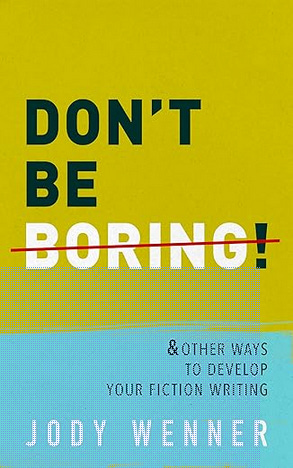Don't Be Boring: A Review, and some thoughts on (yes your) serial fiction
Where I make someone else's great new book entirely about my soapbox
This is an inside baseball newsletter about the writing process. Mostly I am going to review Jody Wenner’s new craft book on writing. However one of the passages struck me as particularly apt to serial fiction, so how can I possibly resist the narcissistic temptation to get on my soapbox?
If you are here for the fiction, don’t worry, the next chapter is slated for release this weekend.
If you bought Total Eclipse during the sale, thank you! Be sure to leave a review!
“If you plan to put out work that you want readers to enjoy and take seriously, you must think of it as a business.”—Jody Wenner
A new writing craft book hit the market yesterday. I am simultaneously going to review it (Spoiler alert: 5 stars), and make this post about me and my serial fiction experience. Because I Am The Author, I do what I want.
Should you buy this book?
Of course, you should. That’s a really dumb question. It’s by Jody Wenner, who has been doing beta reads, developmental editing, and writing books for fifteen years. She has 20 distinct works on Goodreads. She knows a thing or two because she’s written and edited a thing or two.
My view on writing craft books is the same as my mother’s view on recipe books. Mom was in the Successful Italian Restaurant Business. She said if you pay $25 for a cookbook and get one good recipe out of it, it was worth it because you could make it back by serving it to a thousand people.
This book reads like Wenner’s collection of manuscript margin notes, “ohhh… did you really do that? No, no, you shouldn’t.”
There are lots of excellent tips in here that make it well worth the $7.99. If even one of the tips helps you sell a few extra books, you’ve made your money back. There are tips on character development, conflict, foreshadowing (“teasing”), when to query (before or after editing, if you go down that road), many others.
I am not going to go into tremendous detail. I highlighted two dozen or so sections as my own personal reminders. If you are curious about how not to be boring, go buy the book.
One section I do want to discuss from the book: scenes and chapters, specifically as it relates to serializing fiction.
From Chapter 3, story structure:
Sometimes we forget that each chapter has a job to do all on its own. For example, if we consider a single chapter in our manuscript as a scene, or a mini-story in itself, then we know that each chapter needs to have some basic elements we’ve already discussed. In order for a chapter to feel compelling and complete to the reader, it should have us question the same things: (1) What is the character trying to do within this smaller scene/chapter (establish expectations)? (2) What is getting in the way (adding conflict)? (3) What happens if the expectations set out at the beginning of the scene are not met (consequences/stakes)?
This is a mistake I see a lot of serial fictionistas make. When I dive into chapter 27, because I see it on my substack dashboard, I first ask: Why am I here? What is the point of this chapter?
Some authors are very good at giving me a summary and delivering compelling chapters that make me want to move forward or go back and read earlier sections.
Others…dive right into dialogue, or action, or worldbuilding. Here I will just quote Wenner:
The reader has no idea who the character is yet, so it often reads like a jumbled, adrenaline-fueled mess and the stakes aren’t there because we haven’t gotten attached to the MC yet. Why do we care if they survive the high-speed chase?
I’ve started, and not finished, a lot of serial fiction on Substack because:
I did not know why I was there
There was no summary of the story to-date
No link to earlier chapters
No hook for me to get into the chapter
No hook for me to go back and reread
Each chapter of serial fiction starts in media res (literally). People click on chapter 36 because they see it in their feed or they subscribed last week.
Let me say it louder: Each chapter of serial fiction starts in media res.
In fact, I’d argue that serial fiction is the penultimate example of in medias res.
You can’t assume the reader has read the earlier 35 chapters. And even if they did read the earlier 35 chapters, those might have been posted 6 months ago. Who remembers that minute detail from 6 months ago? Not me.
I am reminded of some of the long-running series I’ve completed: Lee Child’s Jack Reacher series, Harlan Coben’s Myron Bolitar series, and Diane Capri’s Hunt for Jack Reacher series. You don’t need to read these books in order. Within each book, they give us gentle reminders of backstory or relevant details that you may have missed or forgotten. Not a lot. Not enough to take us out of the story. Sometimes only a sentence or two. But they do refresh us.
You need to treat each chapter the same.
Now, you are serializing a novel, so obviously, your chapters have to have an overarching story structure. I am not saying each chapter should be a short story. Nor am I suggesting a lot of redundancy.
But, please, please, please, give us a hook. Give us a gentle summary. Assume your reader has come in on the latest chapter and give a sentence of refresher—even if it’s at the beginning before the chapter—but not so much as to take us out of the story.
Most importantly, give us a reason to be there.
I try to do all these things when I deliver serial fiction. Do I succeed? You tell me in the comments.
Go buy Wenner’s book, 5 stars.
Filled with hate?
Buy my book.
Total Eclipse is available an ebook, paperback, and audiobook from Amazon and Barnes and Noble:
Finally, don’t forget we are 26 chapters into Kate Devana’s next electrifying adventure. Stay tuned for the cover reveal and release date in summer 2025.
Catch up here:









